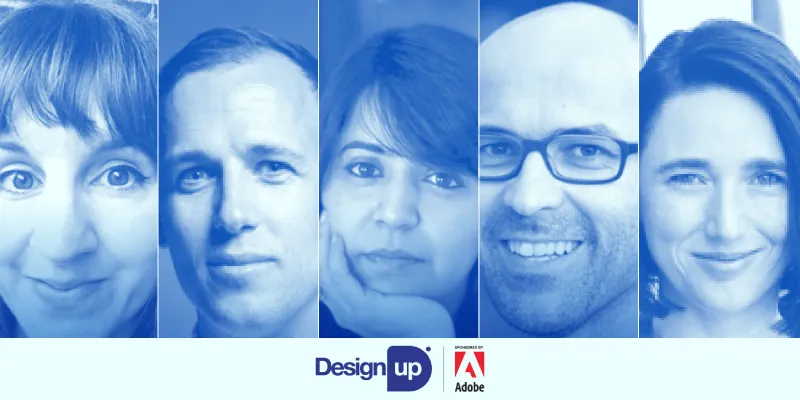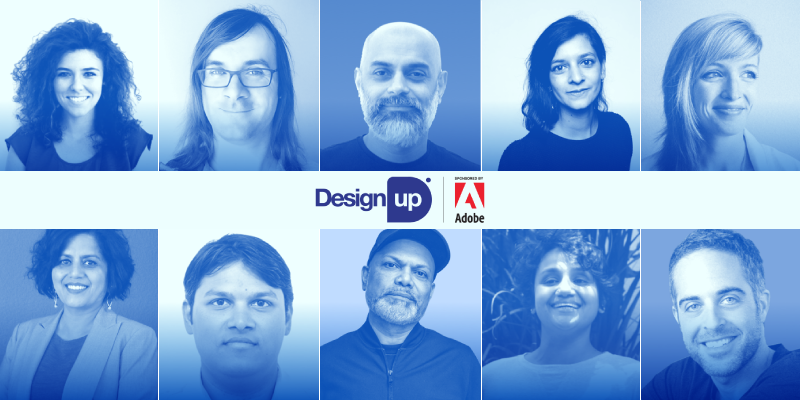‘Design is the great connector’ – the upcoming DesignUp 2018 conference highlights the growing importance of design
Coming up in Bengaluru this week, DesignUp offers three days of workshops, panels and keynote sessions. Here are some expert insights from the speakers, in our second preview article.

The DesignUp 2018 conference, kicking off in Bengaluru on Thursday, features a galaxy of experts addressing the latest changes and challenges in design – and what this means for changemakers and organisational leaders. In our second preview article on DesignUp 2018, we share speaker insights on the design mindset, impacts, and design thinking (see the first preview article here).
Over the years, DesignUp has come to be regarded as one of the Top 20 design conferences in the world (see our coverage of the 2017 edition here). Design is acknowledged as a key success factor for large organisations and startups alike (check out our D-Zen section for more articles, conference reports, and expert tips on design).
Design impacts
“Design in tech, and design for tech, is at a point where it can change behaviours, create new behaviours, create addicts and optimise our time. The possibilities are fascinating and also frightening,” explains Jay Dutta, Senior Vice President for UX Design at leading travel portal MakeMyTrip.com.
“To me ethics, envisioning long term impact, and change are very critical,” he adds. Design should become one of the leading voices of reason, and should speak for the users.
The design of group narratives can also have larger involvement and impact in society. For example, The Indian Memory project builds visual narratives of history based on photographs and letters found in personal archives. It connects people, families, cultures, traditions, and events as remembered by people themselves.
The project was founded in 2010 by Mumbai-based Anusha Yadav, who also runs The Memory Company, a consultancy in areas ranging from book design to digital archives. “The Indian Memory Project takes drops of memories from individuals and converts them into an ocean of collective memory,” she explains.
“India is such a diverse country that it is tough to design media and campaigns that apply on a mass scale. The only common things we seem to have are our currency and national anthem,” Anusha jokes.
NID graduate Anusha is a designer and photographer, and also trained in Indian classical vocal. She was awarded Honorary Mention at the Prix Ars Electronica (2013), an international award given for excellence in Cyber Arts. She sees many similarities between art and design.
“Art can increase awareness about issues, which leads to activism and eventually to solutions. Design makes its presence felt through form and function, and can be leveraged during marketing as well,” she explains (see also YourStory’s PhotoSparks section on arts and design).
While digital media has spawned connections between people on a global scale, some other impacts have been speed and loss of tactility. “Digital interaction removes the requirement of two senses: touch and smell. It is also hurrying things up and eroding our sense of patience, our seventh sense,” she says.
The rise of artificial intelligence is raising other concerns that touch on the economy of the workforce and even the philosophy of life, Anusha observes. This is new and unfamiliar territory, and it is hard to draw conclusions at the moment. (For a deep exploration of these issues, see our book review of Life 3.0 by Max Tegmark.)
Design can also transform the education system, as shown in two recent projects involving museums and children with special needs. “We have been seeking out projects that allow us to scale design's impact to as many people as we can,” explains Divya Viswanathan, Co-Founder at Tropic Design & Innovation.
“The two projects we are currently engaged in coincidentally both involve children. One is to design an inclusive creative museum for children in Mumbai, and the other to design a learning management system for a school that exclusively serves children with special needs,” says Divya, who graduated from Srishti School of Art Design and Technology, and has worked at IDEO and Nokia.
Design thinking: misconceptions and realities
One of the tools from the designer’s repertoire that is gaining wide traction is design thinking, according to Kshitiz Anand, Founder of sustainable design consultancy The Neev. He is also Co-Founder of Happy Horizons Trust, which aims to transform education through methods like design thinking, storytelling, and community-based learning.
He corrects some misconceptions about design thinking: it will not make practitioners designers, it will not bring instant change, it is not a one-time activity, and it is not only for designers. Design thinking actually works best when done in collaboration and the participants are from different work backgrounds, Kshitiz explains.
The design thinking approach is based on empathy, embracing ambiguity, divergent-convergent ideation, creation, and iteration. During a recent visit to IDEO in Palo Alto, Kshitiz showed how the Happy Horizons Trust applied design thinking to education via spending lots of time in understanding the system, connecting to all stakeholders, promoting free as well as critical thinking, making prototypes, and giving motivational feedback.
“Design thinking is a process and a mindset. It should be introduced to children in the middle school years. These are the formative years of deeper critical thinking and it encourages them to practice it on a daily basis,” Kshitiz advises. In colleges, students should take up real world projects and work on actual solutions using the above process.
“When we talk about the 21st century skills (creativity, critical thinking, collaboration and problem solving), I feel design thinking is best suited to promote it,” Kshitiz says. It is encouraging that many business schools are now teaching design thinking, and startups are adopting this approach as well.
“This has resulted in a lot of need-based product companies rather than just project-based companies that start projects without knowing what the users need,” Kshitiz says.

The story of DesignUp
All these speakers will be joining a galaxy of other experts at the DesignUp conference, which has grown significantly over the past three years. “I am surprised, pleasantly,” says conference Founder-Curator Jay Dutta, looking back at the conference’s momentum. “Taken away from a commercial context, it’s those oft-repeated adages playing themselves out: of doing something that you love, not working for the money, and relentless focus on providing user value,” he recalls.
“We never focused on the money, on the numbers or on raising money. That just set us free to create the best event we could, given the constraints. Over time people came: attendees, speakers, sponsors,” Jay explains.
This year, over 700 participants are expected from diverse countries such as Malaysia, Singapore, India, and Indonesia. The speaker lineup features experts from all five continents. There were also pre-conference events held in a number of cities. “Interestingly, even before we open our doors to the conference, more than 730 people would have attended our pre-events in Singapore, Bangalore, Chennai, and Hyderabad,” Jay says.
“Numbers aren't the only yardstick of growth. There are many things that make a conference good - apart from just number of attendees,” he adds. “We’ll have to take a call on how much is too much - I’d rather be that conference that gets sold out and has long waitlists than the one that has 5,000 attendees and average reviews,” says Jay.
All the speakers at the conference have also expressed enthusiasm to connect with local and overseas design experts. “After working outside of India for the past five years and returning to start my own practice, I'm looking forward to taking a moment to pause from design ‘doing’, and absorb all the amazing stories, insights and conversations from this event,” Divya enthuses.
“I'm especially looking forward to hearing about work, stories from India, and meeting local designers who have been shaping the Indian design culture and practice. I believe there is so much to be inspired by looking within our own context. I believe we have a unique design voice and I'm glad there are conferences like this that give it a platform,” she adds.
The design mindset
Due to its inter-disciplinary nature, design connects diverse fields and areas: aesthetics, digital interfaces, product function, service interaction, business logic, and user experience. “Design is the great connector. Designers show us how everything is connected, in the online world and offline,” Anusha explains.
Designers can also help users find balance. “We live in an evolving world of behaviours, and that is a consequence of our design and consumption choices. But there has always been a balance - for every fidget spinner you see, there is a meditation app company bringing pause and respite,” Divya explains.
“There is no doubt that we are in the age of quicker, bite-sized consumption, and reduced attention spans, but I also feel we are responsible for feeding those behaviours. How can we as designers of tools, products, systems and environments create the conditions for depth and exploration,” she asks.
It is possible to pick up basic skills in coding and sketching online, but there is more to design than these skills. “I don't believe the weight of design education should be towards skill-based learning, it should be to prepare you to develop the mindsets and behaviours that make you a designer - like empathy, collaboration, and creative leadership. Design or creative leadership is a skill every designer needs to aspire towards - that's where real change can happen, and real impact can be made,” Divya advises.
“Designers need to think more in systems design perspectives, especially when it comes to managing different stakeholders in complex systems such as healthcare, education, and transportation,” Kshitiz adds.
“I feel it is important for designers to not work in silos but engage more with engineers, researchers, and other members of the team. Organisations should promote collaborative learning and development. This will promote divergent thinking and acceptance of different perspectives,” he advises.
He believes it is critical for designers to step up and be a part of founding teams in startups. India, in particular, is a land full of opportunities where technology can really make a huge difference in bringing need-based solutions to large numbers of users.
For example, designers should pay special attention to first-time users of products like smartphones, when crucial behaviours can be shaped. “In voice-based interactions, designers need to get deeper into understanding of the human brain and psychology. Despite the rise of artificial intelligence and machine learning, the notion of being human-centred takes precedence over anything,” Kshitiz says.
Effective design calls for unbound curiosity, devotion to user needs, and focus on impact. “Curiosity is key - curiosity about the business, about the organisation, its users, and consumers. Curiosity extends to knowing what the design levers are that will make a product or service move and create impact,” Jay advises aspiring designers.
They should also develop clarity about what impact really means, beyond just numbers. “Success is about making an impact - and creating, designing a better world than we were handed. And that involves much more than an app design,” he says.
Designers need to continually upskill themselves as well. “This takes patience and perseverance. Looking back, I have known a lot of very bright talented people - but some of them lacked the perseverance,” Jay recalls.
Everyone wants to “learn” and “grow” fast. “But both of these take time - learning is an inner transformation, not uploading of information. Learning to reinvent needs one to know oneself better - that requires patience. Our careers are super-long marathons,” Jay signs off.











